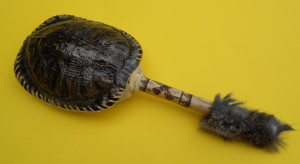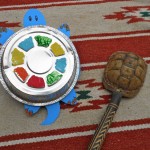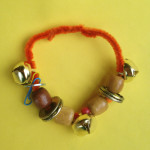 This post was written as a contribution to the Living Life Special Blog Carnival. The participating bloggers are sharing their experiences in parenting or teaching children with special needs. Also included are posts on how to educate others about special needs.
This post was written as a contribution to the Living Life Special Blog Carnival. The participating bloggers are sharing their experiences in parenting or teaching children with special needs. Also included are posts on how to educate others about special needs.
Crafting a simple musical instrument is a satisfying project and parents or siblings can each make their own versions of the same craft for added fun. When the project is complete, you can play your instruments together or along with favorite music. Some instruments; like the quiet rattles or ocean drum, also make excellent activities for taking along in the car or to soothe a child through a rough moment in their day.
Here are three of my favorite crafty musical projects for sharing with kids of all abilities.
 A DRUM THAT SOUNDS LIKE THE OCEAN
A DRUM THAT SOUNDS LIKE THE OCEAN
This is a musical instrument that can be amazingly relaxing. Tilt it gently from side to side and you can hear the sound of the surf or the waves of the sea. If you’ve filled it with things such as colored seed beads, you’ll also see a wonderful variety of patterns move as you listen to the sound of your hand-held drum.
Above is a picture of the actual instrument and here is one of our homemade versions as well. Supplies needed for this project are a thin cardboard box (like a shipping box), clear vinyl or a recycled book report cover and small, roundish items to fill the drum. You can use whatever you have available such as birdseed, dried peas, tiny pasta or small beads. Seed beads of  various colors help create wonderful patterns when this drum is played and tilted from side to side. You’ll also need some clear packing tape to seal up the project and materials for decorating the outside of the box.
various colors help create wonderful patterns when this drum is played and tilted from side to side. You’ll also need some clear packing tape to seal up the project and materials for decorating the outside of the box.
You can find complete step-by-step instructions here:
www.wonderbaby.org/articles/drum-sounds-sea
THE WORLD’S QUIETEST RATTLES
 I love making quiet rattles. They can be played with any type of music and can be different each time you create them.
I love making quiet rattles. They can be played with any type of music and can be different each time you create them.
Supplies needed for this project include any clear recycled container such as a plastic water bottle, soda bottle or milk jug. Then you’ll need some quiet fillings such as q-tips, cotton puffs, paper clips, tiny pasta, sand, salt or sugar. You’ll also need some sturdy tape for sealing your instrument. If you want to add decorative fillings, try confetti, glitter, craft feathers, colorful shredded paper or twisted pipecleaners.
Start with the clean recycled container and begin filling it until you find the sound you like the most. You can find examples of really quiet rattles and complete instructions here:
http://www.theseedsnetwork.com/search_result.php?i=421/
A HOMEMADE RAINSTICK
 Travel to the rainforests by creating your own unique rainstick. Add designs from South America, Australia or the American Southwest. You can also decoupage or quilt one and it will last for years! To make a homemade rainstick, you’ll need sturdy mailing tube (with end caps) a bit of floral wire, jewelry wire, pipecleaners and some different ingredients that will help create the sound of the rain as they trickle back and forth throughout the tube.
Travel to the rainforests by creating your own unique rainstick. Add designs from South America, Australia or the American Southwest. You can also decoupage or quilt one and it will last for years! To make a homemade rainstick, you’ll need sturdy mailing tube (with end caps) a bit of floral wire, jewelry wire, pipecleaners and some different ingredients that will help create the sound of the rain as they trickle back and forth throughout the tube.
Playing a rainstick is easy. You just turn it over and let the magic begin. If you are playing one, few people can resist saying, “hey, can I try that, too!” You can see some additional pictures of creative, homemade rainsticks and complete step-by-step instructions in a pdf here:
http://www.dariamusic.com/docs/RAINSTICK%20Instructions.pdf
WANT TO EXPLORE MORE INSTRUMENTS?
If you and your child would like to explore more musical instruments, feel free to stop by my website. I have a special section set up where you can click on eight different world music instruments and hear them. These instruments include didgeridoos, guitars, guiros, shekeres and pow-wow drums. You can also hear a song with each instrument and can color online or print-out coloring pages for each instrument that you find. Check it out here at:
http://www.dariamusic.com/cajon.php
You can also get creative with 16 other musical instrument crafts such as Latin American maracas, Egyptian sistrums and a Chinese-style gong. Feel free to explore and make them your own!
http://www.dariamusic.com/crafts.php
Be sure to check out the other amazing bloggers who are contributing to the Living Life Special Blog Carnival.
All Things Eyeron - Sylvia from Homeschooling Through Trials, Triumphs, and Tragedies shares a brief account of some experiences in the life of a younger sibling born into the family of a child with special needs.
From Boredom to Hyper-Focusing- Leann from Montessori Tidbits shares how special needs includes children who are gifted, as they have their own special set of needs that must be addressed on a daily basis.
Beating the Loneliness of Special Needs - Kim from Tiaras & Bowties explores the loneliness that can accompany children, especially those with special needs as they journey into young adulthood. Don’t miss these quick tips to help your child beat those feelings of exclusion and rejection while boosting self-esteem
Is There a Child with Special Needs in the Classroom? – Former teacher and insightful author, Susan Case offers guidance on how to prepare students for a child with special needs in the classroom.
One Thing You Should Know – Kim from The Little Stories writes about a mother of a child with autism shares the one that that all of us need to know – the one thing that will show her we understand her child is important and accepted.
I Call You - Sandy from We Can Do All Things, talks about how having a child with special needs pushes a parent into action. They quickly become not just a parent, but a therapist, medical researcher, teacher, advocate, and expert in their child’s diagnosis. They do things they never knew they could do, and be things they never knew they could do.
Fine Motor Leads to Fine Art – Debbie Clement is a children’s musician/song-writer, illustrator, author, and public speaker. The also spent 10 years as a Resource teacher for young children with special needs. Her article for the carnival examines Fine Motor Development and shares supportive observations for children with special needs on that
topic.
 across the USA and Canada. Although the actual rattle is made from a turtle shell, this craft uses supplies that can be found around any house or classroom.
across the USA and Canada. Although the actual rattle is made from a turtle shell, this craft uses supplies that can be found around any house or classroom. Here’s a real and homemade turtle rattle side-by-side. Find the easy and free step-by-steps directions on DARIA’s TPT Store, here:
Here’s a real and homemade turtle rattle side-by-side. Find the easy and free step-by-steps directions on DARIA’s TPT Store, here: So many Native rattles are made from materials found in the natural world. Chapchas – from the Andes – are made of a rather unusual natural material, the clipped toenails of sheep or goats. The nails are boiled and sterilized then a hot needle punctures a hole in the nail so they can be threaded onto a strip of fabric about the size of a bracelet.
So many Native rattles are made from materials found in the natural world. Chapchas – from the Andes – are made of a rather unusual natural material, the clipped toenails of sheep or goats. The nails are boiled and sterilized then a hot needle punctures a hole in the nail so they can be threaded onto a strip of fabric about the size of a bracelet. bells or dried pasta, to name a few.
bells or dried pasta, to name a few. One of our favorite bloggers – Leanna (from All Done Monkey!) just posted this craft that her family made from the book they were reading (The Cherokee by Rennay Craats). In the book, these noise-makers helped a child know what they might hear at a special ceremony of the Cherokee. You can find the activity and the full post here:
One of our favorite bloggers – Leanna (from All Done Monkey!) just posted this craft that her family made from the book they were reading (The Cherokee by Rennay Craats). In the book, these noise-makers helped a child know what they might hear at a special ceremony of the Cherokee. You can find the activity and the full post here:

 This post was written as a contribution to the Living Life Special Blog Carnival. The participating bloggers are sharing their experiences in parenting or teaching children with special needs. Also included are posts on how to educate others about special needs.
This post was written as a contribution to the Living Life Special Blog Carnival. The participating bloggers are sharing their experiences in parenting or teaching children with special needs. Also included are posts on how to educate others about special needs. A DRUM THAT SOUNDS LIKE THE OCEAN
A DRUM THAT SOUNDS LIKE THE OCEAN 

 Travel to the rainforests by creating your own unique rainstick. Add designs from South America, Australia or the American Southwest. You can also decoupage or quilt one and it will last for years! To make a homemade rainstick, you’ll need sturdy mailing tube (with end caps) a bit of floral wire, jewelry wire, pipecleaners and some different ingredients that will help create the sound of the rain as they trickle back and forth throughout the tube.
Travel to the rainforests by creating your own unique rainstick. Add designs from South America, Australia or the American Southwest. You can also decoupage or quilt one and it will last for years! To make a homemade rainstick, you’ll need sturdy mailing tube (with end caps) a bit of floral wire, jewelry wire, pipecleaners and some different ingredients that will help create the sound of the rain as they trickle back and forth throughout the tube.